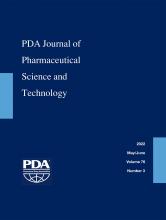Abstract
The number of products being developed for serious conditions that are eligible for expedited programs has been increasing in recent years. This article presents an industry perspective on how to reduce analytical life cycle steps when using analytical platform technologies (APT) in support of accelerated biological product development. Strategies for life cycle steps for APT methods are conceptually reviewed within the framework of supporting chemistry, manufacturing, and control (CMC) development acceleration. Reduced method qualification, transfer, and validation studies could be performed, provided that the initially validated test method remains unchanged. A detailed case study is used to illustrate considerations for the initial method validation and subsequent APT verification studies. Considerations for APT implementation are discussed and suggestions are provided for the submission of APT information in regulatory filings.
- © PDA, Inc. 2022
PDA members receive access to all articles published in the current year and previous volume year. Institutional subscribers received access to all content. Log in below to receive access to this article if you are either of these.
If you are neither or you are a PDA member trying to access an article outside of your membership license, then you must purchase access to this article (below). If you do not have a username or password for JPST, you will be required to create an account prior to purchasing.
Full issue PDFs are for PDA members only.
Note to pda.org users
The PDA and PDA bookstore websites (www.pda.org and www.pda.org/bookstore) are separate websites from the PDA JPST website. When you first join PDA, your initial UserID and Password are sent to HighWirePress to create your PDA JPST account. Subsequent UserrID and Password changes required at the PDA websites will not pass on to PDA JPST and vice versa. If you forget your PDA JPST UserID and/or Password, you can request help to retrieve UserID and reset Password below.






